One of the most popular collectable items associated with the Napoleonic Era is the snuff box. Small, often quite artistic, and generally affordable, the snuff box is an important reflection of Napoleon and his times. Moreover, Napoleon is known to have carried a snuff box with him at all times, and was very fond of giving them as gifts. It was a great honor to be given the opportunity to take a pinch from the Emperor's own box!
Snuff boxes were far more than a simple box in which one carried snuff. They were often meant to be works of art and could be quite elaborate. They were made of all sorts of materials, ranging from papier mache to gold, with decorations that ran from glass to diamonds. Portraits were painted on snuff boxes by famous painters such as Isabey, and by countless unknown artists of varying quality.
While snuff boxes were often items to be carried, the best looking ones were really designed for display. Beautiful woods, carved ivory, and gold or silver medallion inserts all added to the beauty of a snuff box, which in turn enhanced a room's decor. In addition to the snuff (a form of tobacco), these boxes also had a political "content." Napoleon, like most leaders throughout history, liked to see his image widely available to the people. In addition to busts, paintings and prints, snuff boxes became another medium to display and disseminate Napoleonic imagery. To exhibit such a box in the home was yet another way one could show his support of the Emperor.
I saw another marvelous example of the interplay of politics and snuff boxes in a shop in Vienna. The wood box featured a rendition of a well-known painting by Jacques Louis David that had nothing to do with Napoleon. However, when one unscrewed the medallion bearing the portrait, an image of Napoleon was revealed. This box was probably from the period of the First or Second Restoration, perhaps as late as 1815. Napoleon has been in and out of favor over the years since the collapse of his empire. Both Louis Philippe and Napoleon III sought to use Napoleon's image to enhance their own. Thus it is not unusual to find images that glorify Napoleon adorning boxes from the mid-to late 19th century. The fact that a box has a heroic image of the Emperor is no guarantee that it dates from the First Empire. The items shown here are from a collection of some 100 snuff boxes and similar items. That "similar items" notation is important, as many boxes that are included in the category of snuff boxes were actually for other items, such as candy or medicines. Napoleon is reputed to have carried one of each type.
The following is an attempt to highlight a few of the more interesting snuff boxes in this collection:
4. Shell snuff box (at left)with gold medallion showing Napoleon, Marie-Louise, and their son, the King of Rome. Napoleon's star sends rays of success above. The box is dated 1815, and is from the period of the 100 days.
Contributing Editor David Markham is the editor of the Napoleonic Society of America Bulletin. He collects snuff boxes and similar items, as well as porcelains, prints, and books. His decorative arts collection has been featured in several exhibitions, including one in 1989-90 at the Phoenix Art Museum, entitled "Napoleon the Great: Selections from the David Markham Collection." Other museum displays are currently in the planning stages.
This article appears in MagWeb (Magazine Web) on the Internet World Wide Web.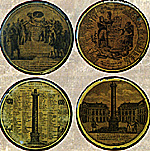 Politics could enter into the realm of snuff boxes in other ways as well. One set in the collection shown here commemorates the Constitutional Charter of 1815, which was "granted" by Louis XVIII upon his ascension to the throne. One box shows Louis granting the Charter. The other, making a sharp political point, shows the same scene but with Napoleon sitting and pointing at the king (at right). The political point is obvious: without Napoleon, there could be no guarantees.
Politics could enter into the realm of snuff boxes in other ways as well. One set in the collection shown here commemorates the Constitutional Charter of 1815, which was "granted" by Louis XVIII upon his ascension to the throne. One box shows Louis granting the Charter. The other, making a sharp political point, shows the same scene but with Napoleon sitting and pointing at the king (at right). The political point is obvious: without Napoleon, there could be no guarantees. 1. Burlwood snuff box (at left) with Dieppe [the name of the French town where it was carved] ivory medallion inset, showing a very accurate copy of Horace Vernet's painting "Bataille de Wagram". This box is probably from the period 1836-1850.
1. Burlwood snuff box (at left) with Dieppe [the name of the French town where it was carved] ivory medallion inset, showing a very accurate copy of Horace Vernet's painting "Bataille de Wagram". This box is probably from the period 1836-1850.
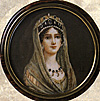 2. Another burlwood snuff box (at right), this one with a signed painting of Joesephine on ivory. Paintings on ivory were very popular throughout the 19th Century. This box is most likely First Empire or perhaps as late as 1820.
2. Another burlwood snuff box (at right), this one with a signed painting of Joesephine on ivory. Paintings on ivory were very popular throughout the 19th Century. This box is most likely First Empire or perhaps as late as 1820.
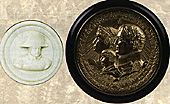 3. This solid ivory box (at far left) shows a bust of Napoleon in military uniform. It is possible that this was carved by a prisoner of war as something they could sell.
3. This solid ivory box (at far left) shows a bust of Napoleon in military uniform. It is possible that this was carved by a prisoner of war as something they could sell.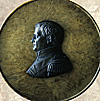 5. This box is not for snuff, but is, in fact, a lady's compact with a screw top. The burlwood box and bronze bust are in superb condition, and the piece dates to the mid-19th Century.
5. This box is not for snuff, but is, in fact, a lady's compact with a screw top. The burlwood box and bronze bust are in superb condition, and the piece dates to the mid-19th Century.
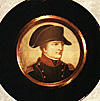 6. This papier mache box (at left) has a fine portrait of Napoleon on an ivory inset. Papier mache was, obviously, more affordable than gold or silver, and this box was likely used by someone from the lower middle class. This box may be First Empire or shortly after.
6. This papier mache box (at left) has a fine portrait of Napoleon on an ivory inset. Papier mache was, obviously, more affordable than gold or silver, and this box was likely used by someone from the lower middle class. This box may be First Empire or shortly after.
 7. This burlwood box (at right) with a gold-plated bronze medallion is one of the best in the collection. The scene shows Napoleon and Tsar Alexander embracing, with King Frederick William III of Prussia standing on the left. They are on a raft in the Nieman River where on 7-9 July, 1807, following the battle of Friedland, the Peace of Tilsit was forged.
7. This burlwood box (at right) with a gold-plated bronze medallion is one of the best in the collection. The scene shows Napoleon and Tsar Alexander embracing, with King Frederick William III of Prussia standing on the left. They are on a raft in the Nieman River where on 7-9 July, 1807, following the battle of Friedland, the Peace of Tilsit was forged.
 8. This fine piece is a two-sided crystal sulfide box (at left) showing the co-joined busts of Napoleon and Marie-Louise on one side and the King of Rome on the other. While technically a box that could be closed, its function was purely for open display. It is dated to be from 1810-1840.
8. This fine piece is a two-sided crystal sulfide box (at left) showing the co-joined busts of Napoleon and Marie-Louise on one side and the King of Rome on the other. While technically a box that could be closed, its function was purely for open display. It is dated to be from 1810-1840.
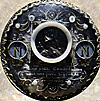 9. This is a candy box (at right) made of glass and cardboard. It has a double glass top. On the bottom glass layer is a medallion of Napoleon in uniform with an Imperial Eagle framed in ivory, two cardboard crowned "N's" (gold on blue), and various decorations that include some small costume jewelry. Hand painted below the medallion is the inscription "Bien petite consolation pour une perte si grande" (A small consolation for a great loss). All this is covered with a curved glass dome. The box is in mint condition and may be unique. It dates from 1814-1821, and was made to mourn the loss of Napoleon, either due to one of his two abdications (1814, 1815) or his death (1821).
9. This is a candy box (at right) made of glass and cardboard. It has a double glass top. On the bottom glass layer is a medallion of Napoleon in uniform with an Imperial Eagle framed in ivory, two cardboard crowned "N's" (gold on blue), and various decorations that include some small costume jewelry. Hand painted below the medallion is the inscription "Bien petite consolation pour une perte si grande" (A small consolation for a great loss). All this is covered with a curved glass dome. The box is in mint condition and may be unique. It dates from 1814-1821, and was made to mourn the loss of Napoleon, either due to one of his two abdications (1814, 1815) or his death (1821).
 10. The final example (at left) is in some ways the most intriguing. It is a bone box with shiny round disks for decoration. Set into the lid is a medallion with Napoleon and Marie-Louise on one side, and the King of Rome on the other. On the edge of the medallion (which must be taken out of the lid to be read) is an inscription that seems to indicate that it may have been a gift from Napoleon. It is doubtful that I'll ever really know for sure, but part of the fun of collecting such items is the chance to imagine who might have at one time used them.
10. The final example (at left) is in some ways the most intriguing. It is a bone box with shiny round disks for decoration. Set into the lid is a medallion with Napoleon and Marie-Louise on one side, and the King of Rome on the other. On the edge of the medallion (which must be taken out of the lid to be read) is an inscription that seems to indicate that it may have been a gift from Napoleon. It is doubtful that I'll ever really know for sure, but part of the fun of collecting such items is the chance to imagine who might have at one time used them.
Back to Table of Contents -- Napoleon #3
© Copyright 1996 by Emperor's Press.
The full text and graphics from other military history magazines and gaming magazines are available at http://www.magweb.com